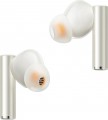Audio delay
Sound delay in wireless headphones is a natural process caused by the specifics of audio data transmission over Bluetooth. It can be either almost imperceptible or clearly interfere with comfortable gameplay or watching video content. This paragraph provides the declared sound delay time in milliseconds, which is written in the technical specifications for a particular headphone model.
Speaker size
The diameter of the speaker installed in the headphones; models with multiple drivers (see "Number of drivers"), usually, the size of the largest speaker is taken into account, other dimensions can be specified in the notes.
In general, this parameter is relevant primarily for over-ear headphones (see "Design"). In them, emitters can have different sizes; the larger it is, the more saturated the sound is and the better the speaker reproduces the bass, however, large emitters have a corresponding effect on the dimensions, weight and price of the headphones. But in-ear "ears" and earbuds, by definition, have very small speakers, and rich bass in them is achieved due to other design features.
Emitter type
The type of sound emitters installed in the headphones. The type determines the principle of operation of emitters and some features of their design.
—
Dynamic. The simplest type of emitters operating on the principle of an electromagnet. Due to the combination of low cost with quite decent performance, it is also the most common, especially among entry-level and mid-range headphones. Such an emitter consists of a magnet, a coil placed in its field, and a membrane attached to the coil. When an alternating current (signal) enters the coil, it begins to vibrate, transmitting vibrations to the membrane and creating sound. From an acoustic point of view, the main advantages of dynamic radiators are a wide frequency range and good volume, the disadvantage is a relatively high probability of distortion, especially with a worn membrane.
—
Reinforcing. A peculiar modification of dynamic emitters (see the relevant paragraph), used mainly in high-end in-ear headphones. The basis of the design of such a radiator is a U-shaped metal plate. One of its ends is fixed motionless, the second, movable, is located between the poles of a permanent magnet, and a coil is wound around it (closer to the crossbar), through which the signal current passes. Vibrating under the action of this current, the movable part of the plate transmits vibrations to a rigid membrane, with which it is connected by a thin need
...le. This technology allows you to achieve good volume and low distortion with a very small size of the earpiece itself. The disadvantages of reinforcing radiators, in addition to high cost, are uneven frequency response and a relatively narrow frequency range. However, in expensive headphones of this type, several emitters can be provided at once, including on a hybrid basis (see relevant paragraph).
— Hybrid. Hybrid devices are usually called devices that combine dynamic and reinforcing emitters. See above for more details on these varieties; and their combination is used to combine advantages and compensate for disadvantages. Usually, in such headphones there is only one dynamic emitter, it is responsible for low frequencies, and there can be several reinforcing ones, they share the midrange and high frequencies. This allows you to achieve a more uniform frequency response than in purely armature models, but it significantly affects the price.
— Planar. The design of emitters of this type includes two powerful permanent magnets, between which there is a thin film membrane. The shape of the headphones themselves can be either round (orthodynamic emitters) or rectangular (isodynamic). According to the principle of operation, such systems are similar to dynamic ones, with the adjustment for the fact that there is no coil in the design — its role is played by the membrane itself with applied conductive tracks, to which the audio signal is fed. Due to this, distortions associated with the uneven oscillations of the membrane are practically absent; in addition, the sound as a whole is clear and reliable, and the frequency response is uniform. The main disadvantages of planar magnetic headphones are high cost, increased requirements for signal quality, and rather large dimensions. In addition, they are somewhat inferior to dynamic ones in terms of volume and overall frequency range.
— Electrostatic. Like planar-magnetic (see the relevant paragraph), such emitters are designed according to the "sandwich" principle. However, the membrane in them is located not between the magnets, but between the metal grids, and is made of a very thin metallized film. An audio signal is connected to such a system in a special way, and the membrane begins to oscillate due to attraction and repulsion from the grids, creating sound. Electrostatic drivers achieve very high sound quality, low distortion, and high fidelity, but they are bulky, complex, and expensive to use. And it's not just the high cost of the headphones themselves — their operation requires additional matching amplifiers with a voltage range of hundreds or even thousands of volts, and such devices cost a lot, and have the appropriate dimensions.Number of emitters
The number of emitters installed in each individual earphone. Specified only for models with
more than one emitter.
The meaning of this feature depends on the type of emitters (see above). So, in hybrid models, by definition, there are several — the frequency range is distributed between them, which has a positive effect on the frequency response. For the same purpose, several reinforcing radiators can be used. And with the traditional dynamic principle of operation, due to several emitters, the effect of surround sound can also be provided (see "Sound").
Anyway, "ears" with numerous emitters, other things being equal, will be more advanced, but also more expensive.
Microphone noise canceling
The presence of a noise reduction system in its own headphone microphone.
In accordance with the name, such a system is designed to eliminate extraneous noise - primarily during conversations. It is usually based on an electronic filter that passes the sound of a human voice and cuts off background sounds such as city noise, the rumble of wind in the microphone grille, etc. As a result, even in noisy environments, thanks to the
noise reduction of the microphone, speech is clear and intelligible; True, the system inevitably introduces distortions into the final sound, but they are not critical in this case.
— ENC. ENC (Environment Noise Cancellation) technology significantly reduces ambient noise with directional microphones. It is used both in gaming devices so that gamers can easily communicate in voice chat, and in TWS earphone models so that you can comfortably talk on the phone in a noisy environment.
— cVc. Microphone noise reduction cVc (Clear Voice Capture) is an advanced technology that is found mainly in expensive headphone models. cVc algorithms effectively suppress echo and noise from the environment. Sound processing using this technology is carried out at several levels at once - the algorithm determines the reference signal-to-noise level, automatically adjusts speech to the desired volume level, applies adaptive equalizers to process the entire voice, as well as specialized filters to remove
...low-frequency bubbling, sibilants and hissing.Mobile app
The ability to operate the functions and settings of headphones through
a mobile application for a smartphone or tablet. Communication between the device and gadgets is usually carried out via the Bluetooth wireless protocol. The mobile application may provide tools for flexible sound settings (equalizer, bass boost, etc.), switching noise reduction and transparency modes, reassigning buttons and gestures, finding lost headphones, etc. Also, the ability to update the headphone firmware is often implemented through the mobile application.
Autopause
A function that allows you to automatically pause the playback track when you remove the headphones (or one headphone).
Autopause is found mainly in wireless models (see "Connection Type") true wireless format (see "Cable Type"); however, there are other types of headphones with this function — for example, with a combined connection and an overhead design. Anyway, the proximity sensor is usually responsible for the auto-pause operation, which is triggered when the earpiece moves away from the ear. This feature is especially useful in situations where, after removing the headphones, there is no time to manually pause playback — for example, you need to urgently respond to what is happening nearby. At the same time, some models are able to automatically resume playback when the earpiece is returned to its place, however, this function is not strictly required — it will not hurt to clarify its presence separately.
Noise cancellation
A system that reduces the influence of ambient noise on the audibility of sound through headphones. "Noise reduction" with the help of a separate microphone (or several micro) "listens" to external sounds and sends the same sounds to the headphones, but in antiphase. Due to this, the noise heard by the ears is attenuated almost to zero and the user can enjoy the sound of the headphones without interference even in a rather “loud” environment. For filtering in headphones, Active Noise Cancellation (ANC) and Environment Noise Cancellation (ENC) systems are used. The first suppresses all the noise around the listener, the second - reduces the noise level of the environment.
Active noise cancellation affects the purity of the sound, but the noise from the outside spoils the picture when listening to audio tracks even more.
Also in the headphones there is an adaptive active noise reduction system Adaptive ANC, aimed at automatically adjusting the sound of the headphones depending on the level of ambient noise. In a noisy environment (for example, when traveling on the subway), the Adaptive ANC system enhances the work of “noise reduction”, in the absence of loud sounds from outside, it weakens the noise reduction.
Transparent mode
A feature that allows the user to hear the sounds of the surrounding world without removing the headphones.
This possibility is relevant mainly for models with a high degree of sound insulation; so the
transparent mode can be found mainly among in-ear models, as well as overhead "ears" of the Over Ear format in a closed acoustic design. A special microphone is responsible for the operation of the function, which “listens” to the surrounding sounds and broadcasts them to the headphones. In Talk Through mode, you can, for example, listen to the interlocutor or control the environment on a busy street. And some headphones with this feature also have more advanced functions, including automatic adjustment to the situation: such models turn on on their own to transmit speech, “hearing” the loud voice of a person nearby. Individual headphones react to loud street noises in the transparent Ambient Aware mode — it means broadcasting noises through the speaker that can be potential danger signals (screams, car signals, etc.).
Note that most models with Talk through also have an active noise reduction function (see above), and the “transparent mode” in them is one of the noise reduction modes. However, exceptions to this rule are possible — technically transparent mode does not have to be combined with noise reduction.

